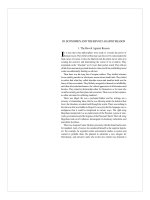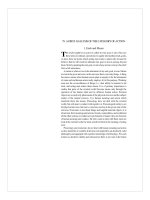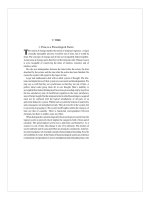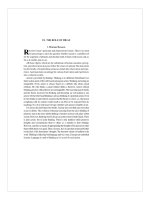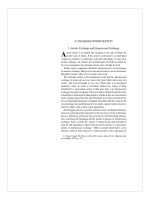Luận án kinh tế - "Human and action" - Chapter 22 pps
Bạn đang xem bản rút gọn của tài liệu. Xem và tải ngay bản đầy đủ của tài liệu tại đây (40.5 KB, 11 trang )
XXII. THE NONHUMAN ORIGINAL FACTORS OF
PRODUCTION
1. General Observations Concerning the Theory of Rent
I
N the frame of Ricardian economics the idea of rent was an attempt at a
treatment of those problems which modern economics approaches by
means of marginal-utility analysis.
1
Ricardo’s theory appears rather unsat-
isfactory when judged from the point of view of present-day insight; there
is no doubt that the method of the subjective-value theory is far superior.
Yet the renown of the rent theory is well deserved; the care bestowed upon
its initiation and perfection brought forth fine fruits. There is no reason for
the history of economic thought to feel ashamed of the rent theory.
2
The fact that land of different quality and fertility, i.e., yielding different
returns per unit of input, is valued differently does not pose any special
problem to modern economics. As far as Ricardo’s theory refers to the
gradation in the valuation and appraisement of pieces of land, it is com-
pletely comprehended in the modern theory of the prices of factors of
production. It is not the content of the rent theory that is objectionable, but
the exceptional position assigned to it in the complex of the economic system.
Differential rent is a general phenomenon and is not limited to the determination
of the prices of land. The sophisticated distinction between “rents” and “quasi-
rents” is spurious. Land and the services it renders are dealt with in the same
way as other factors of production and their services. Control of a better tool
yields “rent” when compared with the returns of less suitable tools which must
be utilized on account of the insufficient supply of more suitable ones. The abler
and more zealous worker earns a “rent” when compared with the wages earned
by his less skillful and less industrious competitors.
The problems which the rent concept was designed to solve were for the
most part generated by the employment of inappropriate terms. The general
1. It was, says Fetter (Encyclopaedia of the Social Sciences, XIII, 291), “a
garbled marginality theory.”
2. Cf. Amonn Ricard als Begründer der theoretischen Nationalökonomie
(Jena, 1924), pp. 54 ff.
notions as used in everyday language and mundane thought were not formed
with regard to the requirements of praxeological and economic investigation.
The early economists were mistaken in adopting them without scruple and
hesitation. Only if one clings naively to general terms such as land or labor, is
one puzzled by the question why land and labor are differently valued and
appraised. He who does not allow himself to be fooled by mere words, but looks
at a factor’s relevance for the satisfaction of human wants, considers it a matter
of course that different services are valued and appraised differently.
The modern theory of value and prices is not based on the classification
of the factors of production as land, capital, and labor. Its fundamental
distinction is between goods of higher and of lower orders, between
producers’ goods and consumers’ goods. When it distinguishes within the
class of factors of production the original (nature-given) factors from the
produced factors of production (the intermediary products) and furthermore
within the class of original factors the nonhuman (external) factors from the
human factors (labor), it does not break up the uniformity of its reasoning
concerning the determination of the prices of the factors of production. The
law controlling the determination of the prices of the factors of production
is the same with all classes and specimens of these factors. The fact that
different services rendered by such factors are valued, appraised, and dealt
with in a different way can only amaze people who fail to notice these
differences in serviceableness. He who is blind to the merits of a painting
may consider it strange that collectors should pay more for a painting of
Velasquez than for a painting of a less gifted artist; for the connoisseur it is
self-evident. It does not astonish the farmer that buyers pay higher prices
and tenants higher leases for more fertile land than for less fertile. The only
reason why the old economists were puzzled by this fact was that they
operated with a general term land that neglects differences in productivity.
The greatest merit of the Ricardian theory of rent is the cognizance of the
fact that the marginal land does not yield any rent. From this knowledge
there is but one step to the discovery of the principle of valuational subjec-
tivism. Yet blinded by the real cost notion neither the classical economists
nor their epigones took this step.
While the differential-rent idea, by and large, can be adopted by the subjec-
tive-value theory, the second rent concept derived from Ricardian economics,
viz., the residual-rent concept, must be rejected altogether. This residual-claim-
ant idea is based on the notion of real or physical costs that do not make any
sense in the frame of the modern explanation of the prices of factors of
636 HUMAN ACTION
production. The reason why the price of Burgundy is higher than that of
Chianti is not the higher price of the vineyards of Burgundy as against those
of Tuscany. The causation is the other way around. Because people are ready
to pay higher prices for Burgundy than for Chianti, winegrowers are ready
to pay higher prices for the vineyards of Burgundy than for those of Tuscany.
In the eyes of the accountant profits appear as a share left over when all costs
of production have been paid. In the evenly rotating economy such a surplus of
the prices of products over and above costs could never appear. In the changing
economy differences between the prices of the products and the sum of the prices
that the entrepreneur has expended for the purchase of the complementary
factors of production plus interest on the capital invested can appear in either
direction, i.e., either as profit or as loss. These differences are caused by changes
which arise in the prices of the products in the time interval. He who succeeds
better than others in anticipating these changes in time and acts accordingly,
reaps profits. He who fails in his endeavors to adjust his entrepreneurial ventures
to the future state of the market is penalized by losses.
The main deficiency of Ricardian economics was that it was a theory of
the distribution of a total product of a nation’s joint efforts. Like the other
champions of classical economics Ricardo failed to free himself from the
Mercantilist image of the Volkswirtschaft. In his thought the problem of the
determination of prices was subordinated to the problem of the distribution
of wealth. The customary characterization of his economic philosophy as
“that of the manufacturing middle classes of contemporary England”
3
misses the point. These English businessmen of the early nineteenth century
were not interested in the total product of industry and its distribution. They
were guided by the urge to make profits and to avoid losses.
Classical economics erred when it assigned to land a distinct place in its
theoretical scheme. Land is, in the economic sense, a factor of production,
and the laws determining the formation of the prices of land are the same
that determine the formation of the prices of other factors of production. All
peculiarities of the economic teachings concerning land refer to some
peculiarities of the data involved.
2. The Time Factor in Land Utilization
The starting point of the economic teachings concerning land is the distinction
between two classes of original factors of production, viz., human and nonhuman
THE NONHUMAN ORIGINAL FACTORS OF PRODUCTION 637
3. Cf., for example, Haney, History of Economic Thought (rev. ed. New York,
1927), p. 275.
factors. As the utilization of the nonhuman factors is as a rule connected with the
power to utilize a piece of the earth, we speak of land when referring to them.
4
In dealing with the economic problems of land, i.e., the nonhuman original
factors of production, one must neatly separate the praxeological point of view
from the cosmological point of view. It may make good sense for cosmology
in its study of cosmic events to speak of permanency and of the conservation of
mass and energy. If one compares the orbit within which human action is able
to affect the natural environmental conditions of human life with the operation
of natural entities, it is permissible to call the natural powers indestructible and
permanent or—more precisely—safe against destruction by human action. For
the great periods of time to which cosmology refers, soil erosion (in the broadest
sense of the term) of such an intensity as can be effected by human interference
is of no importance. Nobody knows today whether or not cosmic changes will
in millions of years transform deserts and barren soil into land that from the
point of view of our present-day knowledge will have to be described as
extremely fertile and the most luxuriant tropical gardens into sterile land.
Precisely because nobody can anticipate such changes nor venture to influence
the cosmic events which possibly could bring them about, it is supererogatory
to speculate about them in dealing with the problems of human action.
5
The natural sciences may assert that those powers of the soil that condition
its serviceableness for forestry, cattle breeding, agriculture, and water utilization
regenerate themselves periodically. It may be true that even human endeavors
deliberately directed toward the utmost devastation of the productive capacity
of the earth’s crust could at best succeed only with regard to small parts of it.
But these facts do not strictly count for human action. The periodical regener-
ation of the soil’s productive powers is not a rigid datum that would face man
with a uniquely determined situation. It is possible to use the soil in such a way
that this regeneration is slowed down and postponed or the soil’s productive
power either vanishes altogether for a definite period of time or can be restored
only by means of a considerable input of capital and labor. In dealing with the
soil man has to choose between various methods different from one another
with regard to the preservation and regeneration of its productive power. No
less than in any other branch of production the time factor enters also into the
638 HUMAN ACTION
4. Legal provisions concerning the separation of the right of hunting, fishing,
and extracting mineral deposits from the other rights of the owner of a piece of
land are of no interest for catallactics. The term land as used in catallactics
includes also expanses of water.
5. Thus also the problem of entropy stands outside the sphere of praxeological
meditation.
conduct of hunting, fishing, grazing, cattle breeding, plant growing, lumbering
and water utilization. Here too man must choose between satisfaction in nearer
and in more remote periods of the future. Here too the phenomenon of originary
interest, entailed in every human action, plays its paramount role.
There are institutional conditions that cause the persons involved to prefer
satisfaction in the nearer future and to disregard entirely or almost entirely
satisfaction in the more distant future. If the soil is on the one hand not owned
by individual proprietors and on the other hand all, or certain people favored by
special privilege or by the actual state of affairs, are free to make use of it
temporarily for their own benefit, no heed is paid to the future. The same is the
case when the proprietor expects that he will be expropriated in the not too
distant future. In both cases the actors are exclusively intent upon squeezing out
as much as possible for their immediate advantage. They do not concern
themselves about the temporally more remote consequences of their methods
of exploitation. Tomorrow does not count for them. The history of lumbering,
hunting, and fishing provides plenty of illustrative experience; but many exam-
ples can also be found in other branches of soil utilization.
From the point of view of the natural sciences, the maintenance of capital
goods and the preservation of the powers of the soil belong to two entirely
different categories. The produced factors of production perish sooner or
later entirely in the pursuit of production processes, and piecemeal are
transformed into consumers’ goods which are eventually consumed. If one
does not want to make the results of past saving and capital accumulation
disappear, one must, apart from consumers’ goods, also produce the amount
of capital goods which is needed for the replacement of those worn out. If
one were to neglect this, one would finally consume, as it were, the capital
goods. One would sacrifice the future to the present; one would live in luxury
today and be in want later.
But, it is often said, it is different with the powers of land. They cannot
be consumed. Such a statement is meaningful, however, only from the point
of view of geology. But from the geological point of view one could, or
should, no less deny that factory equipment or a railroad can be “eaten up.”
The gravel and stones of a railroad’s substructure and the iron and steel of
the rails, bridges, cars, and engines do not perish in a cosmic sense. Only from
the praxeological point of view is it permissible to speak of the consumption,
the eating up, of a tool, a railroad, or a steel mill. In the same economic sense
we speak of the consumption of the productive powers of the soil. In forestry,
agriculture, and water utilization these powers are dealt with in the same way
THE NONHUMAN ORIGINAL FACTORS OF PRODUCTION 639
as other factors of production. With regard to the powers of the soil, too, the
actors must choose between processes of production which render higher
output at the expense of productivity in later periods and processes which
do not impair future physical productivity. It is possible to extract so much
from the soil that its later utilization will render smaller returns (per unit of
the quantities of capital and labor employed) or practically no returns at all.
It is true that there are physical limits to the devastating powers of man.
(These limits are sooner reached in lumbering, hunting, and fishing than in
tilling the soil.) But this fact results only in a quantitative, not in a qualitative
difference between capital decumulation and soil erosion.
Ricardo calls the powers of the soil “original and indestructible.”
6
How-
ever, modern economics must stress the point that valuation and appraise-
ment do not differentiate between original and produced factors of produc-
tion and that the cosmological indestructibility of mass and energy, whatever
it may mean, does not enjoin upon land utilization a character radically
different from other branches of production.
3. The Submarginal Land
The services a definite piece of land can render in a definite period of
time are limited. If they were unlimited, men would not consider land a factor
of production and an economic good. However, the quantity of soil available
is so vast, nature is so prodigal, that land is still abundant. Therefore, only
the most productive pieces of land are utilized. There is land which people
consider—either with regard to its physical productivity or with regard to
its location—as too poor to be worth cultivating. Consequently the marginal
soil, i.e., the poorest soil cultivated, yields no rent in the Ricardian sense.
7
Submarginal land would be considered entirely worthless if one were not to
appraise it positively in anticipation of its being utilized in later days.
8
The fact that the market economy does not have a more ample supply of
agricultural products is caused by the scarcity of capital and labor, not by a
scarcity of cultivable land. An increase in the surface of land available
640 HUMAN ACTION
6. Ricardo, Principles of Political Economy and Taxation, p. 34.
7. There are areas in which practically every corner is cultivated or otherwise
utilized. But this is the outcome of institutional conditions barring the
inhabitants of these regions from access to more fertile unused soil.
8. The appraisal of a piece of soil must not be confused with the appriasal of
the improvements, i.e., the irremovable and inconvertible results of the
investment of capital and labor that facilitate its utilization and raise future
outputs per unit and future inputs.
would—other things being equal—increase the supply of cereals and meat
only if the additional land’s fertility exceeded that of the marginal land
already previously cultivated. On the other hand, the supply of agricultural
products would be increased by any increase in the amount of labor and
capital available, provided the consumers do not consider another employ-
ment of the additional amount of capital and labor more appropriate to fill
their most urgent wants.
9
The useful mineral substances contained in the soil are limited in quantity.
It is true that some of them are the outgrowth of natural processes which are
still going on and increasing the existing deposits. However, the slowness
and length of these processes makes them insignificant for human action.
Man must take into account that the available deposits of these minerals are
limited. Every single mine or oil source is exhaustible; many of them are
already exhausted. We may hope that new deposits will be discovered and
that technological procedures will be invented which will make it possible
to utilize deposits which today cannot be exploited at all or only at unrea-
sonable costs. We may also assume that the further progress of technological
knowledge will enable later generations to utilize substances which cannot
be utilized today. But all these things do not matter for the present-day
conduct of mining and oil drilling. The deposits of mineral substances and
their exploitation are not characterized by features which would give a
particular mark to human action dealing with them. For catallactics the
distinction between soil used in agriculture and that used in mining is merely
a distinction of data.
Although the available quantities of these mineral substances are limited,
and although we may academically concern ourselves with the possibility
that they will be entirely exhausted one day, acting men do not consider
these deposits rigidly limited. Their activities take into account the fact that
definite mines and wells will become exhausted, but they do not pay heed
to the fact that at an unknown later date all the deposits of certain minerals
may come to an end. For to present-day action the supply of these substances
appears to be so abundant that one does not venture to exploit all their
deposits to the full extent which the state of technological knowledge
permits. The mines are utilized only as far as there is no more urgent
employment available for the required quantities of capital and labor. There
are therefore submarginal deposits that are not utilized at all. In every mine
THE NONHUMAN ORIGINAL FACTORS OF PRODUCTION 641
9. These observations, of course, refer only to conditions in which there are
no institutional barriers to the mobility of capital and labor.
operated the extent of the production is determined by the relation between
the prices of the products and those of the required nonspecific factors of
production.
4. The Land as Standing Room
The employment of land for the location of human residences, work-
shops, and means of transportation withdraws pieces of soil from other
employments.
The particular place which older theories attributed to urban site rent need
not here concern us. It is not especially noteworthy that people pay higher prices
for land they value more for housing than for land which they value less. It is a
matter of fact that for workshops, warehouses, and railroad yards people prefer
locations which reduce costs of transportation, and that they are ready to pay
higher prices for such land in accordance with the economies expected.
Land is also used for pleasure grounds and gardens, for parks and for the
enjoyment of the grandeur and beauty of nature. With the development of
the love of nature, this very characteristic feature of “bourgeois” mentality,
the demand for such enjoyments increased enormously. The soil of the high
mountain chains, once merely considered a barren dreariness of rocks and
glaciers, is today highly appreciated as the source of the most lofty pleasures.
From time immemorial access to these spaces has been free to everybody.
Even if the land is owned by private individuals, the owners as a rule have not
the right to close it to tourists and mountain-climbers or to ask an entrance fee.
Whoever has the opportunity to visit these areas, has the right to enjoy all their
grandeur, and to consider them his own, as it were. The nominal owner does
not derive any advantage from the satisfaction his property gives to the visitors.
But this does not alter the fact that this land serves human well-being and is
appreciated accordingly. The ground is subject to an easement that entitles
everybody to pass along and to camp on it. As no other utilization of the area
concerned is possible, this servitude completely exhausts all the advantages the
proprietor could reap from his ownership. Since the particular services which
these rocks and glaciers can render are practically inexhaustible, do not wear
out, and do not require any input of capital and labor for their conservation, this
arrangement does not bring about those consequences which appeared wherever
it was applied to lumbering, hunting, and fishing grounds.
If, in the neighborhood of these mountain chains, the space available for
the construction of shelters, hotels, and means of transportation (e.g., rack
railroads) is limited, the owners of these scarce pieces of soil can sell or rent
642 HUMAN ACTION
them on more propitious terms and thus divert to themselves a part of the
advantages the tourists reap from the free accessibility of the peaks. If this
is not the case, the tourists enjoy all these advantages gratuitously.
5. The Prices of Land
In the imaginary construction of the evenly rotating economy buying and
selling of the services of definite pieces of land does not differ at all from
buying and selling the services of other factors of production. All these
factors are appraised according to the services they will render in various
periods of the future, due allowance being made for time preference. For the
marginal land (and, of course, for the submarginal land) no price is paid at
all. Rent-bearing land (i.e., land that, compared with the marginal land, bears
a higher output per unit of input of capital and labor) is appraised in
accordance with the degree of its superiority. Its price is the sum of all its
future rents, each of them discounted at the rate of originary interest.
10
In the changing economy people buying and selling land take due account
of expected changes in the market prices for the services rendered by the soil.
Of course, they may err in their expectations; but this is another thing. They try
to anticipate to the best of their abilities future events that may alter the market
data and they act in accordance with these opinions. If they believe that the
annual net yield of the piece of land concerned will rise, the price will be higher
than it would have been in the absence of such expectations. This is, for instance,
the case with suburban land in the neighborhood of cities growing in population
or with forests and arable land in countries in which pressure groups are likely
to succeed in raising, by means of tariffs, the prices of timber and cereals. On
the other hand, fears concerning the total or partial confiscation of the net yield
of land tend to lower the prices of land. In everyday business language people
speak of the “capitalization” of the rent and observe that the rate of capitalization
is different with different classes of land and varies even within the same class
with different pieces of soil. This terminology is rather inexpedient as it
THE NONHUMAN ORIGINAL FACTORS OF PRODUCTION 643
10. There is need to remember again that the imaginary construction of the
evenly rotating economy cannot be carried consistently to its ultimate logical
consequences (see above, p. 248). with regard to the problems of land one must
stress two ponits: First, that in the frame of this imaginary construction,
characterized by the absence of changes in the conduct of affairs, there is no
room for the buying and selling of land. Second, that in order to integrate into
this construction mining and oil drilling we must ascribe to the mines and oil
wells a permanent character and must disregard the possibility that any fo the
operated mines and wells could be exhausted or even undergo a change in the
quantity of output or of current input required.
misrepresents the nature of the process.
In the same way in which buyers and sellers of land take into account
anticipated future events that will reduce the net return, they deal with taxes.
Taxes levied upon land reduce its market price to the extent of the discounted
amount of their future burden. The introduction of a new tax of this kind
which is likely not to be abolished results in an immediate drop in the market
price of the pieces of land concerned. This is the phenomenon that the theory
of taxation calls amortization of taxes.
In many countries the owners of land or of certain estates enjoyed special
political legal privileges or a great social prestige. Such institutions too can
play a role in the determination of the prices of land.
The Myth of the Soil
Romanticists condemn the economic theories concerning land for their
utilitarian narrow-mindedness. Economists, they say, look upon land from
the point of view of the callous speculator who degrades all eternal values
to terms of money and profit. Yet, the glebe is much more than a mere factor
of production. It is the inexhaustible source of human energy and human
life. Agriculture is not simply one branch of production among many other
branches. It is the only natural and respectable activity of man, the only
dignified condition of a really human existence. It is iniquitous to judge it
merely with regard to the net returns to be squeezed out of the soil. The soil
not only bears the fruits that nourish our body; it produces first of all the
moral and spiritual forces of civilization. The cities, the processing indus-
tries, and commerce are phenomena of depravity and decay; their existence
is parasitic; they destroy what the ploughman must create again and again.
Thousands of years ago, when fishing and hunting tribesmen began to
cultivate the soil, romantic reverie was unknown. But if there had lived
romanticists in those ages, they would have eulogized the lofty moral values
of the hunt and would have stigmatized soil cultivation as a phenomenon of
depravity. They would have reproached the ploughman for desecrating the
soil that the gods had given to man as a hunting ground and for degrading it
to a means of production.
In the preromantic ages in his actions no one considered the soil as
anything other than a source of human well-being, a means to promote
welfare. The magic rites and observances concerning the soil aimed at
nothing else than improvement of the soil’s fertility and increase in the quantity
of fruits to be harvested. These people did not seek the unio mystica with the
mysterious powers and forces hidden in the soil. All they aimed at was bigger
and better crops. They resorted to magic rituals and adjurations because in their
644 HUMAN ACTION
opinion this was the most efficient method of attaining the ends sought. Their
sophisticated progeny erred when they interpreted these ceremonies from
an “idealistic” point of view. A real peasant does not indulge in ecstatic
babble about the soil and its mysterious powers. For him land is a factor of
production, not an object of sentimental emotions. He covets more land
because he desires to increase his income and to improve his standard of
living. Farmers buy and sell land and mortgage it; they sell the produce of
land and become very indignant if the prices are not as high as they want
them to be.
Love of nature and appreciation of the beauties of the landscape were
foreign to the rural population. The inhabitants of the cities brought them to
the countryside. It was the city-dwellers who began to appreciate the land
as nature, while the countrymen valued it only from the point of view of its
productivity for hunting, lumbering, crop raising and cattle breeding. From
time immemorial the rocks and glaciers of the Alps were merely waste land
in the eyes of the mountaineers. Only when the townsfolk ventured to climb
the peaks, and brought money into the valleys, did they change their minds.
The pioneers of mountain-climbing and skiing were ridiculed by the indig-
enous population until they found out that they could derive gain from this
eccentricity.
Not shepherds, but sophisticated aristocrats and city-dwellers were the
authors of bucolic poetry. Daphnis and Chloe are creations of fancies far
removed from earthy concerns. No less removed from the soil is the modern
political myth of the soil. It did not blossom from the moss of the forests and
the loam of the fields, but from the pavements of the cities and the carpets
of the salons. The farmers make use of it because they find it a practical
means of obtaining political privileges which raise the prices of their
products and of their farms.
THE NONHUMAN ORIGINAL FACTORS OF PRODUCTION 645


